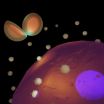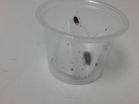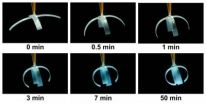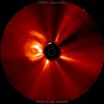(Press-News.org) Called BRIGHTs, the tiny probes described in the online issue of Advanced Materials on Nov. 15, bind to biomarkers of disease and, when swept by an infrared laser, light up to reveal their location.
Tiny as they are, the probes are exquisitely engineered objects: gold nanoparticles covered with molecules called Raman reporters, in turn covered by a thin shell of gold that spontaneously forms a dodecahedron.
The Raman reporters are molecules whose jiggling atoms respond to a probe laser by scattering light at characteristic wavelengths.
The shell and core create an electromagnetic hotspot in the gap between them that boosts the reporters' emission by a factor of nearly a trillion.
BRIGHTs shine about 1.7 x 1011 more brightly than isolated Raman reporters and about 20 times more intensely than the next-closest competitor probe, says Srikanth Singamaneni, PhD, assistant professor of mechanical engineering and materials science in the School of Engineering & Applied Science at Washington University in St. Louis.
Goosing the signal from Raman reporters
Singamaneni and his postdoctoral research associate Naveen Gandra, PhD, tried several different probe designs before settling on BRIGHTS.
Singamaneni's lab has worked for years with Raman spectroscopy, a spectroscopic technique that is used to study the vibrational modes (bending and stretching) of molecules. Laser light interacts with these modes and the molecule then emits light at higher or lower wavelengths that are characteristic of the molecule,
Spontaneous Raman scattering, as this phenomenon is called, is by nature very weak, but 30 years ago scientists accidently stumbled on the fact that it is much stronger if the molecules are adsorbed on roughened metallic surfaces. Then they discovered that molecules attached to metallic nanoparticles shine even brighter than those attached to rough surfaces.
The intensity boost from surface-enhanced Raman scattering, or SERS, is potentially huge. "It's well-known that if you sandwich Raman reporters between two plasmonic materials, such as gold or silver, you are going to see dramatic Raman enhancement," Singamaneni says.
Originally his team tried to create intense electromagnetic hot spots by sticking smaller particles onto a larger central particle, creating core-satellite assemblies that look like daisies.
"But we realized these assemblies are not ideal for bioimaging," he says, "because the particles were held together by weak electrostatic interactions and the assemblies were going to come apart in the body."
Next they tried using something called Click chemistry to make stronger covalent bonds between the satellites and the core.
"We had some success with those assemblies," Singamaneni says, "but in the meantime we had started to wonder if we couldn't make an electromagnetic hot spot within a single nanoparticle rather than among particles.
"It occurred to us that if we put Raman reporters between the core and shell of a single particle could we create an internal hotspot."
That idea worked like a charm.
A rainbow of probes carefully dispensing drugs?
The next step, says Singamaneni, is to test BRIGHTS in vivo in the lab of Sam Achilefu, PhD, professor of radiology in the School of Medicine.
But he's already thinking of ways to get even more out of the design.
Since different Raman reporter molecules respond at different wavelengths, Singamaneni says, it should be possible to design BRIGHTS targeted to different biomolecules that also have different Raman reporters and then monitor them all simultaneously with the same light probe.
And he and Gandra would like to combine BRIGHTS with a drug container of some kind, so that the containers could be tracked in the body and the drug and released only when it reached the target tissue, thus avoiding many of the side effects patients dread.
Good things, as they say, come in small packages.
INFORMATION:
Tiny probes shine brightly to reveal the location of targeted tissues
So BRIGHT, you need to wear shades
2012-11-21
ELSE PRESS RELEASES FROM THIS DATE:
IUDs don't cause pelvic inflammatory disease in women
2012-11-21
The risk of developing pelvic inflammatory disease (PID) following insertion of an intrauterine device (IUD) is very low, whether or not women have been screened beforehand for gonorrhea and chlamydia, according to a joint study of nearly 60,000 women by researchers at the University of California, San Francisco (UCSF), and Kaiser Permanente Northern California Division of Research.
The study appears this week in the current online issue of Obstetrics & Gynecology, the official journal of the American College of Obstetricians and Gynecologists, also known as Green Journal.
The ...
New electrically-conductive polymer nanoparticles can generate heat to kill colorectal cancer cells
2012-11-21
WINSTON-SALEM, N.C., – Nov. 20, 2012 – Researchers at Wake Forest Baptist Medical Center have modified electrically-conductive polymers, commonly used in solar energy applications, to develop revolutionary polymer nanoparticles (PNs) for a medical application. When the nanoparticles are exposed to infrared light, they generate heat that can be used to kill colorectal cancer cells.
The study was directed by Assistant Professor of Plastic and Reconstructive Surgery, Nicole H. Levi-Polyachenko, Ph.D., and done in collaboration with colleagues at the Center for Nanotechnology ...
Natural fungus may provide effective bed bug control
2012-11-21
UNIVERSITY PARK, Pa. -- "And don't let the bed bugs bite" is no longer a harmless adage. In reality today, these bloodthirsty bugs infest thousands of homes. According to a team of Penn State entomologists, biopesticides -- naturally occurring microorganisms -- might provide an answer to this pest problem.
Bed bugs need blood meals for growth and development throughout their life cycle. Increased travel, widespread insecticide resistance and changes in management practices have caused a resurgence in those insects throughout North America and Europe. Compounding the problem ...
Scotch tape finds new use as grasping 'smart material'
2012-11-21
WEST LAFAYETTE, Ind. – Scotch tape, a versatile household staple and a mainstay of holiday gift-wrapping, may have a new scientific application as a shape-changing "smart material."
Researchers used a laser to form slender half-centimeter-long fingers out of the tape. When exposed to water, the four wispy fingers morph into a tiny robotic claw that captures water droplets.
The innovation could be used to collect water samples for environmental testing, said Babak Ziaie, a Purdue University professor of electrical and computer engineering and biomedical engineering.
The ...
Adenotonsillectomy may help resolve obstructive sleep apnea in children with Prader-Willi syndrome
2012-11-21
Children with Prader-Willi syndrome may receive relief from sleep disorders after undergoing an adenotonsillectomy, suggests a new study from Nationwide Children's Hospital published in the November print issue of the Archives of Otolaryngology-Head and Neck Surgery.
"Patients with Prader-Willi syndrome are at risk for sleep disordered breathing as growth hormone commonly used to treat their condition can cause the tonsils and adenoids to enlarge," said the study's lead author Kris Jatana, MD, FAAP, with Otolaryngology Head & Neck Surgery at Nationwide Children's.
"Growth ...
NASA spacecraft observe Nov. 20 solar eruption
2012-11-21
On Nov. 20, 2012, at 7:09 a.m. EST, the sun erupted with a coronal mass ejection or CME. Not to be confused with a solar flare, a CME is a solar phenomenon that can send solar particles into space and can reach Earth one to three days later. When Earth-directed, CMEs can affect electronic systems in satellites and on Earth.
Experimental NASA research models, based on observations from the Solar Terrestrial Relations Observatory (STEREO), show that the Nov. 20 CME left the sun at speeds of 450 miles per second, which is a slow to average speed for CMEs. CMEs can cause ...
MRI shows brain disruption in patients with post-concussion syndrome
2012-11-21
OAK BROOK, Ill. – MRI shows changes in the brains of people with post-concussion syndrome (PCS), according to a new study published online in the journal Radiology. Researchers hope the results point the way to improved detection and treatment for the disorder.
PCS affects approximately 20 percent to 30 percent of people who suffer mild traumatic brain injury (MTBI)—defined by the World Health Organization as a traumatic event causing brief loss of consciousness and/or transient memory dysfunction or disorientation. Symptoms of PCS include headache, poor concentration ...
More help needed to improve smoking cessation services for pregnant women with mental disorders
2012-11-21
Pregnant women with mental health disorders are facing too many barriers to help them quit smoking during pregnancy despite their willingness to accept support, finds a new study published today (21 November) in BJOG: An International Journal of Obstetrics and Gynaecology.
The study, undertaken by researchers at King's College London, looked at referrals to smoking cessation services and what barriers pregnant women with mental health disorders face compared to those women without disorders.
Overall 400 women, who reported smoking at their first appointment, were monitored ...
Harrisburg Pedestrian Deaths Hint At National Trend
2012-11-21
Harrisburg pedestrian deaths hint at national trend
On the morning of October 31, 2012, a 16-year-old girl was struck and killed by a large vehicle in the intersection of South 13th and Sycamore in Harrisburg, Pennsylvania. The fatal accident occurred shortly before 9:00 a.m. as parents walked their children to nearby Foose Elementary School.
Initial news reports indicated that the driver had fled the scene, but he has since been identified and has reportedly been cooperating with the authorities. Investigators are working to determine whether the driver knew he had ...
New California Law Guards Consumers From LTC Insurance Premium Increases
2012-11-21
New California law guards consumers from LTC insurance premium increases
California legislatures recently passed a new law designed to protect consumers from being taken advantage of by insurance companies providing long-term care, or LTC, policies. These insurance policies are designed to provide consumers with assistance funding long-term care facilities like assisted living facilities, nursing homes and home care programs.
Long-term care facilities may be needed when an individual is no longer able to take care of themselves. Insurance companies consider a person ...
LAST 30 PRESS RELEASES:
Numbers in our sights affect how we perceive space
SIMJ announces global collaborative book project in commemoration of its 75th anniversary
Air pollution exposure and birth weight
Obstructive sleep apnea risk and mental health conditions among older adults
How talking slows eye movements behind the wheel
The Ceramic Society of Japan’s Oxoate Ceramics Research Association launches new international book project
Heart-brain connection: international study reveals the role of the vagus nerve in keeping the heart young
Researchers identify Rb1 as a predictive biomarker for a new therapeutic strategy in some breast cancers
Survey reveals ethical gaps slowing AI adoption in pediatric surgery
Stimulant ADHD medications work differently than thought
AI overestimates how smart people are, according to HSE economists
HSE researchers create genome-wide map of quadruplexes
Scientists boost cell "powerhouses" to burn more calories
Automatic label checking: The missing step in making reliable medical AI
Low daily alcohol intake linked to 50% heightened mouth cancer risk in India
American Meteorological Society announces Rick Spinrad as 2026 President-Elect
Biomass-based carbon capture spotlighted in newly released global climate webinar recording
Illuminating invisible nano pollutants: advanced bioimaging tracks the full journey of emerging nanoscale contaminants in living systems
How does age affect recovery from spinal cord injury?
Novel AI tool offers prognosis for patients with head and neck cancer
Fathers’ microplastic exposure tied to their children’s metabolic problems
Research validates laboratory model for studying high-grade serous ovarian cancer
SIR 2026 delivers transformative breakthroughs in minimally invasive medicine to improve patient care
Stem Cell Reports most downloaded papers of 2025 highlight the breadth and impact of stem cell research
Oxford-led study estimates NHS spends around 3% of its primary and secondary care budget on the health impacts of heat and cold in England
A researcher’s long quest leads to a smart composite breakthrough
Urban wild bees act as “microbial sensors” of city health.
New study finds where you live affects recovery after a hip fracture
Forecasting the impact of fully automated vehicle adoption on US road traffic injuries
Alcohol-related hospitalizations from 2016 to 2022
[Press-News.org] Tiny probes shine brightly to reveal the location of targeted tissuesSo BRIGHT, you need to wear shades




